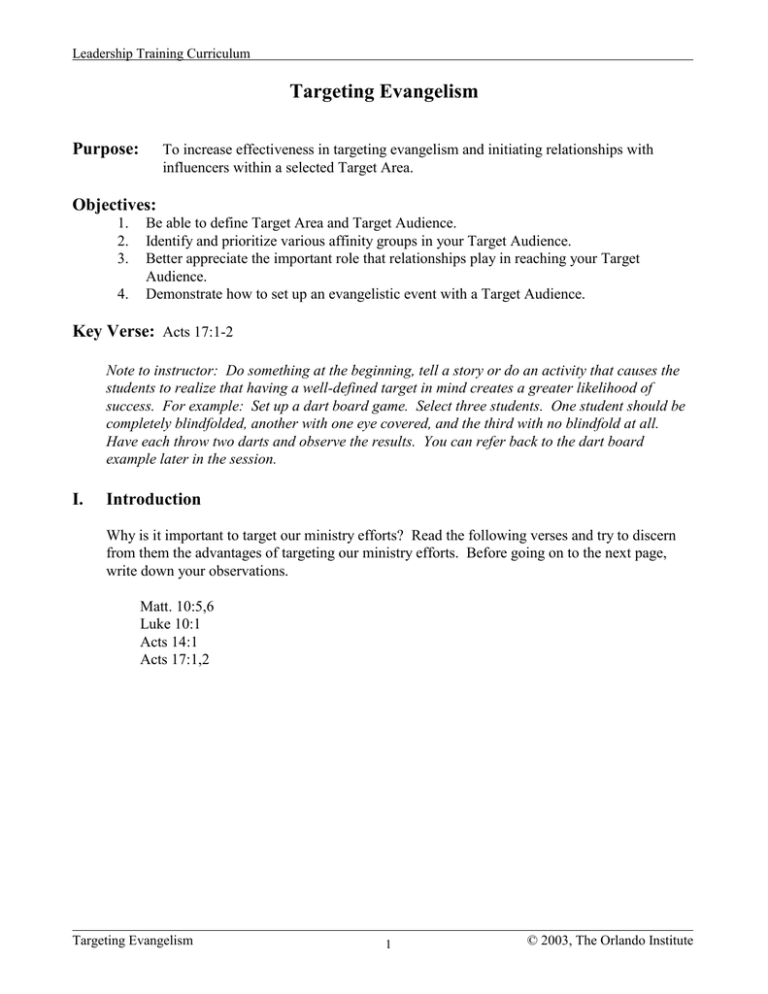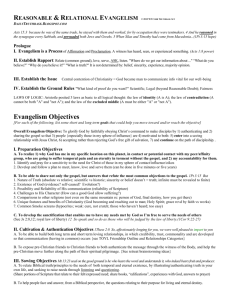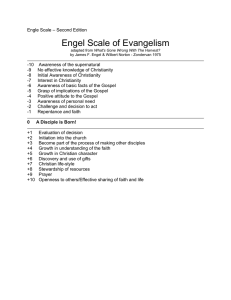Targeting Evangelism Purpose:
advertisement

Leadership Training Curriculum Targeting Evangelism Purpose: To increase effectiveness in targeting evangelism and initiating relationships with influencers within a selected Target Area. Objectives: 1. 2. 3. 4. Be able to define Target Area and Target Audience. Identify and prioritize various affinity groups in your Target Audience. Better appreciate the important role that relationships play in reaching your Target Audience. Demonstrate how to set up an evangelistic event with a Target Audience. Key Verse: Acts 17:1-2 Note to instructor: Do something at the beginning, tell a story or do an activity that causes the students to realize that having a well-defined target in mind creates a greater likelihood of success. For example: Set up a dart board game. Select three students. One student should be completely blindfolded, another with one eye covered, and the third with no blindfold at all. Have each throw two darts and observe the results. You can refer back to the dart board example later in the session. I. Introduction Why is it important to target our ministry efforts? Read the following verses and try to discern from them the advantages of targeting our ministry efforts. Before going on to the next page, write down your observations. Matt. 10:5,6 Luke 10:1 Acts 14:1 Acts 17:1,2 Targeting Evangelism 1 © 2003, The Orlando Institute Leadership Training Curriculum The four verses showed us that it is best to begin where God is most likely at work and where we will have the greatest chance of success. It is best to focus our resources to make a maximum impact on a certain area, thus establishing a beachhead from which to reach out to other areas because the gospel spreads most easily through natural existing relationships. We are more likely to be effective and comfortable reaching our peers. Business people are more likely to reach other business people, mothers to mothers, students to students. Look up John 1:40-51; John 4:39; and Acts 16:13-15 and write down examples of people reaching out to their peers. Note to Instructor: Ask students what they wrote here. After some have shared, be sure the following points were mentioned: Andrew brought Peter to Jesus, Philip found Nathanael; the Samaritan woman was instrumental in the conversion of many from her village; Lydia led members in her household to Christ. II. Definitions: A. Target Area = a geographical area, including all people groups within the area. (i.e. Greater Jacksonville); this is usually a million person area. B. Target Audience = a particular segment of the target area. (i.e. A small campus, a social group, minorities, or athletes on a campus.). A target audience is a specific group of people that you (and your small group) attempt to reach. C. Personal Target Audience = a mini-target audience (i.e. Student Government officials for that year, the soccer team, your neighbors, the Latin American Student Association, etc.). It is assigned to or adopted by a disciple/mentor to reach. III. Benefits of Targeting Your Evangelism A. Natural groupings of people are often the best source of filtered contacts for evangelism and they are more likely to continue growing together in Christ. B. It provides a better environment for spiritual multiplication. C. Multiplying disciples have a manageable piece of the Great Commission. D. Faith grows as one trusts God in taking the specific steps needed to reach a target area/audience. Targeting Evangelism 2 © 2003, The Orlando Institute Leadership Training Curriculum E. It is more productive to focus personal ministry. F. Ministry results can be more easily measured. IV. Saturating a Target Area/Audience (see “Definition of Terms” in Appendix 1) A. B. Saturation is NOT: 1. Every person hearing a gospel presentation. 2. Every interested person hearing a gospel presentation with no available opportunity for ongoing growth. Saturation IS: 1. Every interested person having had multiple, attractive opportunities to hear the gospel. 2. Every interested person having heard a clear, culturally relevant presentation of the gospel with the opportunity to go on in their faith. Why is it important to clearly understand these definitions? Instructor can ask the class for answers they came up with. After they have shared their answers, be sure to mention these if they have not already been mentioned: 1. The team might not give enough multiple exposure opportunities (because one exposure may not be enough). 2. They may want to move on to a new target area – abandoning the previous one which may have many new believers who need to grow into multiplying disciples. 3. They would not know when to expand to another harvest field. Our role in saturating target areas is to give every person multiple attractive opportunities to hear the gospel. We want those who express interest to hear a clear presentation of the gospel. God’s role is that He leads us to the interested people, and He uses exposure opportunities to create an interest in the gospel. V. Choosing a Target Audience A. Size Factor How large or small does it need to be? 1. The target should be large enough to require some large group Targeting Evangelism 3 © 2003, The Orlando Institute Leadership Training Curriculum 2. 3. evangelism. The target should be large enough to see spiritual multiplication take place. The target should be small enough to establish a sense of momentum and a visible presence. Instructor could say as he/she points to the dart board target, “The size of the target affects the accuracy of the thrower. In choosing a ministry target area, if it’s too large – you will feel overwhelmed; if it’s too small – you won’t see spiritual multiplication take place. B. Responsiveness To what degree are those in our target audience open to hearing and responding to the gospel as well as being multiplying disciples? Instructor could say, “If our dart board is made of metal, it won’t be responsive to the darts.” C. Influence Our goal is to eventually reach everyone in the target area, but some groups may have significant influence in reaching others. By targeting them first, you can reach the rest of the target area more quickly and effectively. To what degree are those in our target audience able to influence others, thus help in saturating the whole target area? Who are the opinion setters and “people-movers?” Instructor could say, “Just as the center of the target has a greater influence or point value, we need to target those who could help influence others in the area.” D. Accessibility How easy is it to initially contact and meet with these people? How available will they be to continue meeting if they are responsive? For example, in a university ministry, first-year students would be good to target because you could work with them for four years, they’re not so involved in many other things yet, and they would be the most open to the gospel. Instructor could say, “If the dart board is hidden in a closet, you can’t hit the target.” E. Motivation Is the target audience composed of those whom we are naturally motivated to reach? After you’ve chosen a target audience, you need to begin to build relationships. Instructor could say, “If you want to be good at the dart board game, you need to enjoy doing it. If we want to reach a target audience, we need to be motivated internally to do it.” VI. Initiating Relationships With Target Area Influencers When you have selected your target area and identified key influencers in that area, you then want to introduce yourself to them. The key influencers may or may not “fear the Lord.” Pray for God Targeting Evangelism 4 © 2003, The Orlando Institute Leadership Training Curriculum to give you favor in their eyes (Acts 2:47). Trust God to be sensitive and tactful, gentle and respectful (1 Peter 3:15). Remember that you are Christ’s ambassador (2 Corinthians 5:20). Following are some tips to help you carry out your ambassadorial duties: A. Choose the most appropriate manner to initiate a meeting. You could: 1. Send a letter of introduction 2. Phone for an appointment 3. Meet through a third party 4. Meet informally at a social event 5. Initiate a meeting “cold” without an introduction or third party 6. Pursue a combination of two or more of the above B. Begin your conversation. 1. Consider generic questions: about family, home town, leadership duties, etc. 2. Consider common ground: are there common interests or people you both know? 3. Consider upcoming events: Are there any events on campus or in the community that are in the news or about which you both have an interest? 4. Consider problems/issues: Are there issues, concerns or problems you are both aware of and are interested in discussing? C. Bring up your purpose for meeting together. Are you meeting to: 1. Conduct a “formal” interview or survey? (See Appendix B) 2. Set up a meeting with the group they represent? 3. Get their permission for an activity or event? 4. Share the gospel with them? 5. Determine if they are interested in hearing the gospel at a future meeting? 6. Offer your services as a speaker or share with them the speakers you have available that may be of use to them? D. Close the appointment graciously. 1. Be sensitive to their schedule and interest level. 2. End on a positive note. a. Express sincere appreciation for the meeting. b. As appropriate, schedule a time and place for the next meeting. E. Follow through faithfully. 1. Acknowledge the meeting through a phone call or letter. 2. Continue to pray. 1 Timothy 2:1-4 3. Consider an appropriate way to initiate or meet again. a. Watch for events that they are a part of or interested in. b. Consider inviting them to events you think they are interested in (Christian or secular). Be sure to go with them. c. Ask them for help as appropriate; i.e., in setting up an event together. d. Watch for chance meetings. VII. Application Targeting Evangelism 5 © 2003, The Orlando Institute Leadership Training Curriculum Along with your team, work through the attached Target Audience Assessment Worksheet. Choose 3 to 5 Target Audiences to do further research on in preparation for setting up an Evangelistic Meeting (described in the next class lesson) with them. Discussion Questions: 1. What is a Target Area and Target Audience? 2. How will you identify and prioritize various affinity groups in your Target Audience? 3. How has this talk helped you better appreciate the important role that relationships play in reaching your Target Audience? 4. How would you set up an evangelistic event with a Target Audience. Targeting Evangelism 6 © 2003, The Orlando Institute Leadership Training Curriculum Appendix A – Definition of Terms As we seek to help fulfill the Great Commission, we are committed to giving every person in the target area an opportunity to hear about the love and forgiveness of Jesus. Of course, this will become more and more a reality as the local movement grows toward the saturation and continuation of its development. Evangelize/Saturate To “evangelize” or “saturate” a target area/audience whether it be the target area at large or a specific part of the target area involves winning and multiplying. There are at least two dimensions of evangelistic activity. “Exposure” Defined First, it involves exposure. To expose means to give 100% of the target area or target audience several attractive opportunities to choose to hear the gospel. “Several” opportunities are needed in the event that the first opportunities are at inopportune times. “Attractive” opportunities are necessary so that our strategy or methodology is not a hindrance to someone’s attendance or attentiveness to the gospel presentation. Exposure may come through: 1. publicity for evangelistic presentations 2. broad sowing of evangelistic materials 3. personal invitations to attend meetings or events where the gospel will be communicated clearly 4. broad sowing media strategies that appeal to “felt” needs. The objective of 100% exposure of each target area/audience is within the control of the local movement. While we can’t ensure everyone will come and listen to the gospel, we can at least give them an attractive, meaningful opportunity to do so. It is only within the context of 100% exposure that we can discuss the difficulties of quantifying our efforts to “win” (present the gospel) a target area/audience for Christ. “Winning” Defined Secondly, saturating a target area/audience means winning people to Christ. This means giving a clear presentation of the gospel with a clear call for decision to all who are willing to listen. It is our prayerful desire that as much as 50% (documented) of the target area/audience will be given the opportunity to say “yes” to Christ in the context of a clear, culturally relevant presentation of the gospel. Targeting Evangelism 7 © 2003, The Orlando Institute Leadership Training Curriculum Success in Saturation It is beyond our control to ensure any specific percentage of our target area/audience being willing to listen to the gospel. The 50% figure is simply our prayerful desire should God see fit to bless our evangelistic efforts. To the degree we have given 100% of our target area/audience the opportunity to choose to hear the gospel (exposure) and given all who God has made willing to hear an opportunity to say “yes” to Christ, we have successfully fulfilled our saturation objective. The percentage of those actually hearing a clear, culturally relevant presentation of the gospel will vary from target area to target area given the level of spiritual preparedness. “Saturate” Defined With all this in mind, we can define success in target area/audience saturation as: 1. Every interested person has had multiple attractive opportunities to hear the gospel. 2. Every interested person has heard a clear, culturally relevant presentation of the gospel with the opportunity to go on in their faith. We can also state that saturation is not: 1. Every person hearing a gospel presentation. 2. Every interested person hearing a gospel presentation with no available opportunity for ongoing growth. We also seek to prepare the unreached as we are reaching the prepared. God asks us to be faithful to the opportunities He lays before us and to be full of faith, expecting Him to do great things. Multiplication and Saturation To multiply in the context of target area/audience saturation means to prayerfully work toward at least one percent of that target area/audience being focused on living, sharing and multiplying their faith in the context of a discipleship group. As with the area of “winning,” the one percent figure is our prayerful desire. If 1% of a target area’s population were involved in discipleship groups, the entire population would then hear the gospel over several years. A leadership corps of 0.1% of the target area’s population would be required to disciple this 1%. Targeting Evangelism 8 © 2003, The Orlando Institute Leadership Training Curriculum Appendix B Sample Survey of Key Influencers 1. What qualities do you think make a man or woman a leader? 2. In your opinion, what are the major problems confronting people in our community/(on our campus) today? 3. What major problems are confronting people of the world today? 4. It has been said that a leader is someone who knows where he is going and can motivate others to follow him. Do you feel confident that you know where you are going? 5. As a leader, what do you hope to accomplish in your lifetime? 6. People often follow the example set by others. a. Is there someone who has served as a model leader for you? (Why or why not?) b. Are you satisfied with the model you project to others? (Why or why not?) 7. Most people who have had the opportunity to investigate the evidence agree that Jesus Christ is the most outstanding leader of history. In your opinion, what qualities of leadership did He demonstrate? 8. Jesus Christ can be known in a personal way. Have you ever had the opportunity to begin a relationship with Him? Targeting Evangelism 9 © 2003, The Orlando Institute Leadership Training Curriculum TARGET AUDIENCE ASSESSMENT This chart is designed to assist you in identifying key target audiences for saturation. The goal of this exercise is to generally determine the top priority target audiences. It is not meant to precisely rate each target audience. 1. 2. Identify as many target audiences as possible. Category by category, rank each target audience (i.e. if you have 8 target audiences, "8" is the highest score in any given category). TARGET AUDIENCE NAME Targeting Evangelism ACCESS INFLUENCE Easy to Get to 10 TIME OPENNESS POTENTIAL (Availability) (To the Gospel) (Long Term Involvement) TOTAL © 2003, The Orlando Institute



